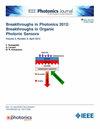Research on the Ground Vacuum Shortwave Calibration of Moon-Based Earth Radiation Budget Detector
IF 2.1
4区 工程技术
Q3 ENGINEERING, ELECTRICAL & ELECTRONIC
引用次数: 0
Abstract
The Moon-based Earth Radiation budget Detector (MERD) is an instrument designed to measure the Earth-reflected Solar Radiation (ERSR) and the Earth thermal radiation from the Moon as part of future mission of China's Chang'e project. The accuracy of its calibration technology directly determines the measurement precision. For traceability to International System of Units (SI) and improve the calibration accuracy in the ERSR wave band, a vacuum shortwave radiance calibration system is built, which consists of an in-situ traceable Electrical Substitution Transfer Radiometer (ESTR) and a Shortwave Calibration Light Source (SWCLS). Where, SWCLS is designed with a electrically variable slit and a 12-hole narrow-band filter wheel to achieve continuous broad-spectrum radiance output and discrete narrow-spectrum band tuning, respectively. Additionally, wide dynamic range output is from the introduction of elliptic land spherical mirrors for bilateral highly efficient focusing structure. This paper presents the mathematical process of shortwave calibration and focuses on the design and analysis of SWCLS based on high stability, radiance and uniformity. Results show that light source stability is 0.05922%/h, radiance uniformity is 99.49% at the calibration distance of 300 mm, the range of output radiant brightness in the spectral range 0.3–2.5 μm is 0.03–1272.20 W/m 2 /sr.月基地球辐射预算探测器的地面真空短波校准研究
月基地球辐射预算探测器(MERD)是为测量来自月球的地球反射太阳辐射(ERSR)和地球热辐射而设计的仪器,是中国嫦娥项目未来任务的一部分。其校准技术的准确性直接决定了测量精度。为溯源至国际单位制(SI)并提高ERSR波段的校准精度,建立了真空短波辐射校准系统,该系统由一个原位可溯源的电置换辐射计(ESTR)和一个短波校准光源(SWCLS)组成。其中,SWCLS 设计有一个电可变狭缝和一个 12 孔窄波段滤光轮,可分别实现连续的宽光谱辐射输出和离散的窄波段调谐。此外,宽动态范围输出还得益于引入椭圆地球面镜的双边高效聚焦结构。本文介绍了短波校准的数学过程,并重点讨论了基于高稳定性、高辐射度和高均匀性的 SWCLS 的设计和分析。结果表明,光源稳定性为 0.05922%/h,校准距离为 300 mm 时辐射均匀度为 99.49%,光谱范围 0.3-2.5 μm 的输出辐射亮度范围为 0.03-1272.20 W/m2/sr。
本文章由计算机程序翻译,如有差异,请以英文原文为准。
求助全文
约1分钟内获得全文
求助全文
来源期刊

IEEE Photonics Journal
ENGINEERING, ELECTRICAL & ELECTRONIC-OPTICS
CiteScore
4.50
自引率
8.30%
发文量
489
审稿时长
1.4 months
期刊介绍:
Breakthroughs in the generation of light and in its control and utilization have given rise to the field of Photonics, a rapidly expanding area of science and technology with major technological and economic impact. Photonics integrates quantum electronics and optics to accelerate progress in the generation of novel photon sources and in their utilization in emerging applications at the micro and nano scales spanning from the far-infrared/THz to the x-ray region of the electromagnetic spectrum. IEEE Photonics Journal is an online-only journal dedicated to the rapid disclosure of top-quality peer-reviewed research at the forefront of all areas of photonics. Contributions addressing issues ranging from fundamental understanding to emerging technologies and applications are within the scope of the Journal. The Journal includes topics in: Photon sources from far infrared to X-rays, Photonics materials and engineered photonic structures, Integrated optics and optoelectronic, Ultrafast, attosecond, high field and short wavelength photonics, Biophotonics, including DNA photonics, Nanophotonics, Magnetophotonics, Fundamentals of light propagation and interaction; nonlinear effects, Optical data storage, Fiber optics and optical communications devices, systems, and technologies, Micro Opto Electro Mechanical Systems (MOEMS), Microwave photonics, Optical Sensors.
 求助内容:
求助内容: 应助结果提醒方式:
应助结果提醒方式:


